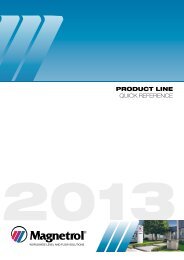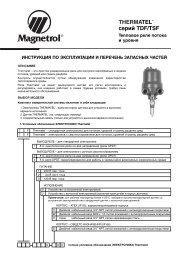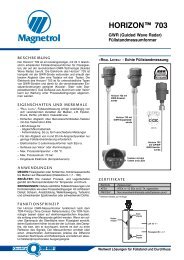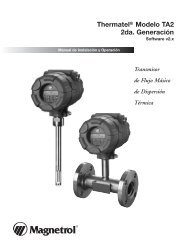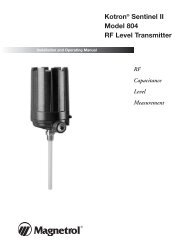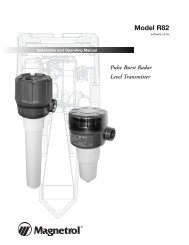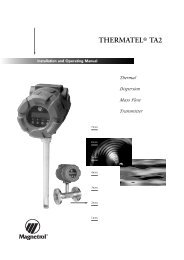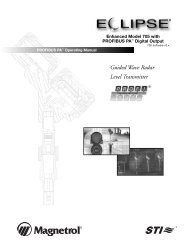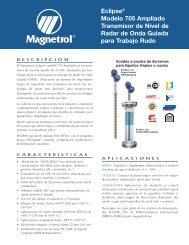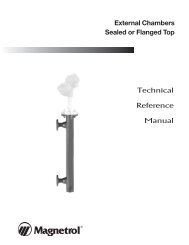Instruction Manual - Magnetrol International
Instruction Manual - Magnetrol International
Instruction Manual - Magnetrol International
You also want an ePaper? Increase the reach of your titles
YUMPU automatically turns print PDFs into web optimized ePapers that Google loves.
LOAD<br />
Close on low level (NC)<br />
COMMON (C)<br />
Close on high level (NO)<br />
LOAD<br />
LINE<br />
4<br />
5<br />
6<br />
NOTES: 1. Rising level closes contacts 5 & 6.<br />
2. Falling level closes contacts 4 & 5.<br />
LOAD<br />
Close on low level (NC)<br />
COMMON (C)<br />
Close on high level (NO)<br />
LOAD<br />
LINE<br />
LOAD<br />
Close on low level (NC)<br />
COMMON (C)<br />
Close on high level (NO)<br />
LOAD<br />
LINE<br />
Upper Level Range Operates<br />
Upper Switch Mechanism<br />
ASSEM.<br />
A<br />
1<br />
2<br />
3<br />
Lower Level Range Operates<br />
Lower Switch Mechanism<br />
ASSEM.<br />
B<br />
4<br />
5<br />
6<br />
NOTES: 1. Rising level closes contacts 5 & 6 and 2 & 3.<br />
2. Falling level closes contacts 4 & 5 and 1 & 2.<br />
ASSEM.<br />
LOAD B<br />
Close on low level (NC) 4<br />
COMMON (C)<br />
5<br />
Close on high level (NO) 6<br />
LOAD<br />
LINE<br />
LOAD<br />
Close on low level (NC)<br />
COMMON (C)<br />
Close on high level (NO)<br />
LOAD<br />
LINE<br />
LOAD<br />
Close on low level (NC)<br />
COMMON (C)<br />
Close on high level (NO)<br />
LOAD<br />
LINE<br />
Upper Level Range Operates<br />
Upper Switch Mechanism<br />
Middle Level Range Operates<br />
Middle Switch Mechanism<br />
ASSEM.<br />
A<br />
1<br />
2<br />
3<br />
Lower Level Range Operates<br />
Lower Switch Mechanism<br />
ASSEM.<br />
B<br />
4<br />
5<br />
6<br />
NOTES: 1. Rising level closes contacts 5 & 6 and 2 & 3.<br />
2. Falling level closes contacts 4 & 5 and 1 & 2.<br />
INTERNAL<br />
CIRCUIT<br />
Figure 7 – Single Stage with SPDT contacts<br />
Figure 8 – Dual Stage with SPDT contacts<br />
INTERNAL<br />
CIRCUIT<br />
Figure 9 – Triple Stage with SPDT contacts<br />
INTERNAL<br />
CIRCUIT<br />
INTERNAL<br />
CIRCUIT<br />
INTERNAL<br />
CIRCUIT<br />
INTERNAL<br />
CIRCUIT<br />
11. Check cover to base fit to be certain gasketed joint is tight.<br />
A positive seal is necessary to prevent infiltration of moisture<br />
laden air or corrosive gasses into switch housings.<br />
3.0 Preventive Maintenance<br />
Periodic inspections are a necessary means to keep your<br />
level control in good working order. This control is a safety<br />
device to protect the valuable equipment it serves. A systematic<br />
program of “preventive maintenance” must be<br />
implemented when the control is placed into service. If the<br />
following sections on “What to do” and “What to avoid”<br />
are observed, your control will provide reliable protection<br />
of your equipment for many years.<br />
3.1 What to do<br />
3.1.1 Keep control clean<br />
Be sure the switch housing cover is always in place on the<br />
control. This cover is designed to keep dust and dirt from<br />
interfering with switch mechanism operation. It protects<br />
against damaging moisture and acts as a safety feature by<br />
keeping bare wires and terminals from being exposed.<br />
Should the housing cover or any seal become damaged or<br />
misplaced, obtain a replacement immediately.<br />
3.1.2 Inspect switch mechanisms, terminals, and<br />
connections monthly<br />
1. Dry contact switches should be inspected for excessive<br />
wear on actuating lever or misalignment of adjustment<br />
screw at point of contact between screw and lever. Such<br />
wear can cause false switch actuating levels. See switch<br />
mechanism bulletin supplied with control should switch<br />
adjustment or replacement be necessary.<br />
2. DO NOT operate your control with defective or maladjusted<br />
switch mechanisms (refer to bulletin on switch<br />
mechanisms furnished for service instructions.)<br />
3. Level controls may sometimes be exposed to excessive heat<br />
or moisture. Under such conditions, insulation on electrical<br />
wiring may become brittle, eventually breaking or pealing<br />
away. The resulting “bare” wires can cause short circuits.<br />
NOTE: Check wiring carefully and replace at the first sign of brittle<br />
insulation.<br />
8 45-610 Displacer Type Liquid Level Switches and Proof-er ® Switches



